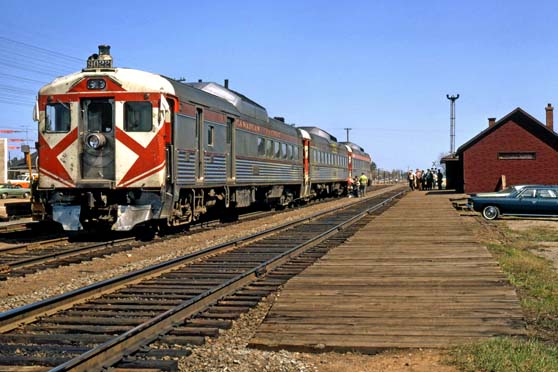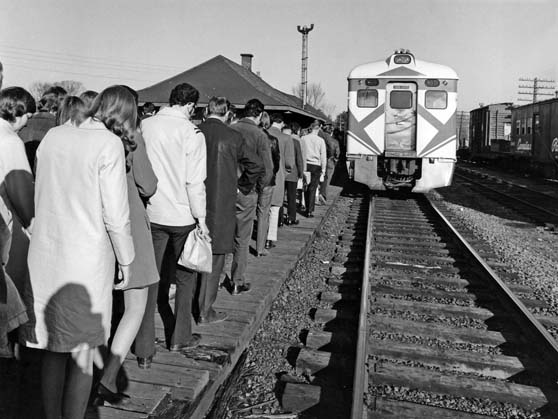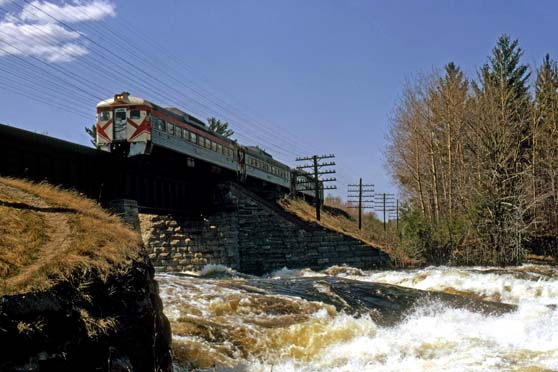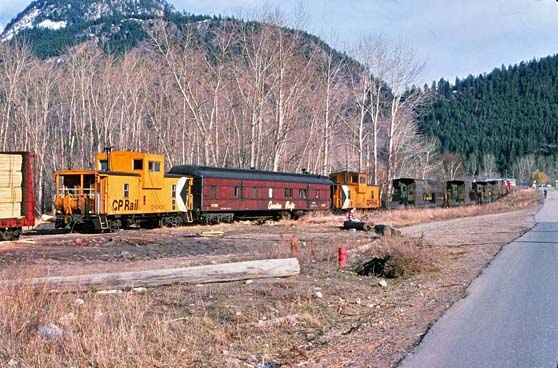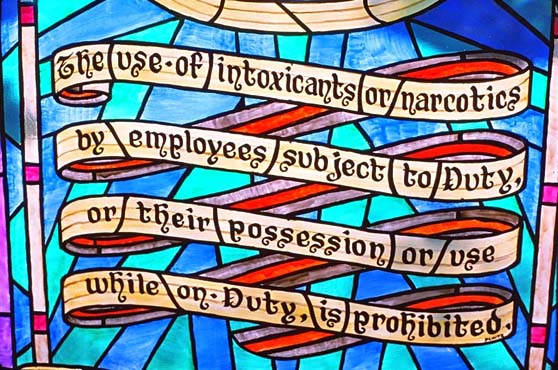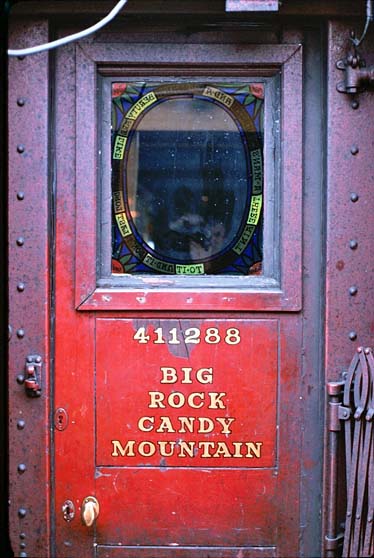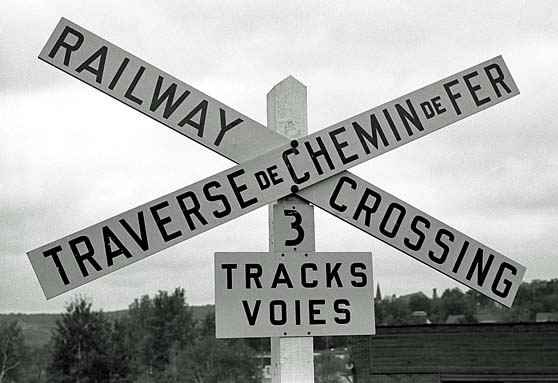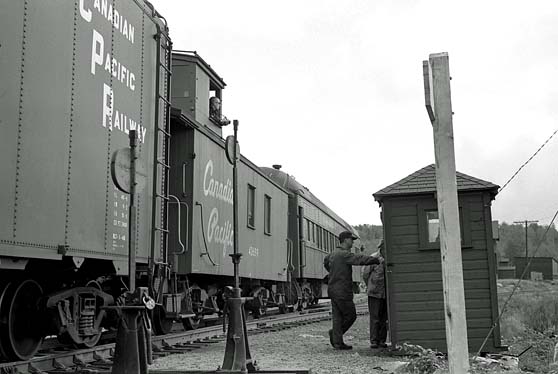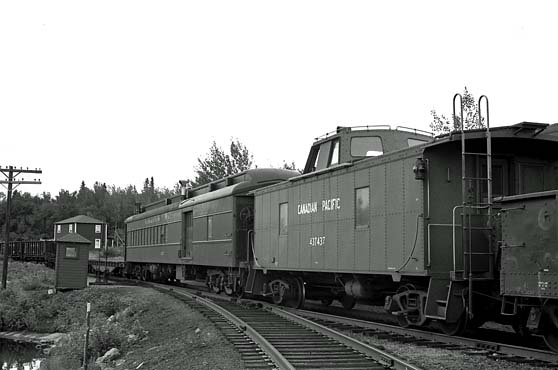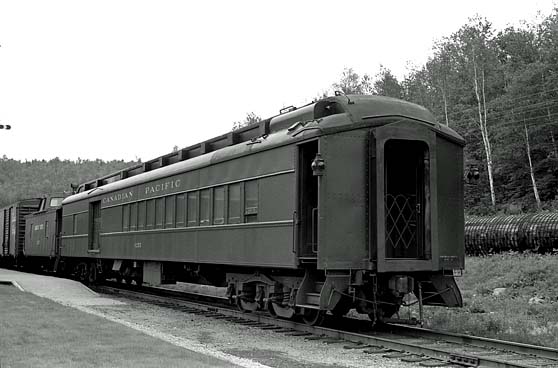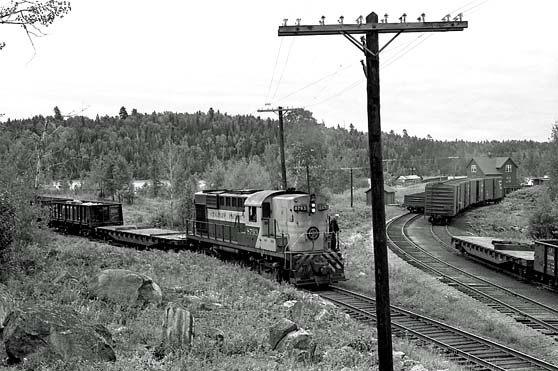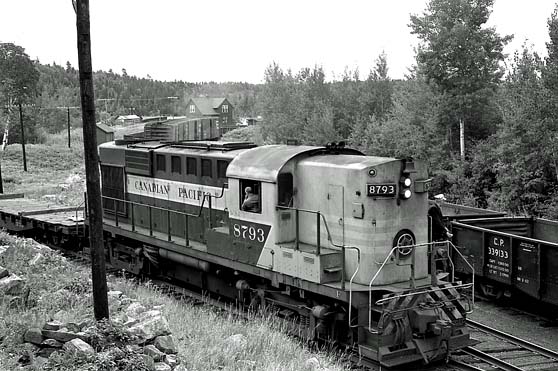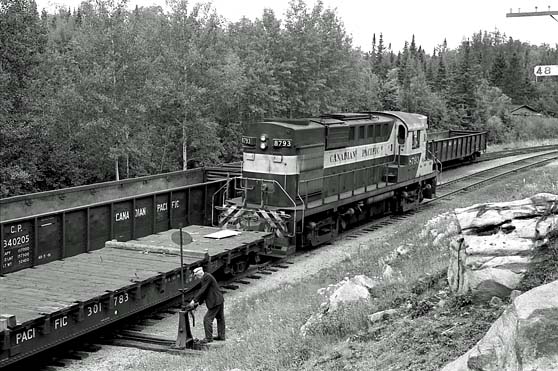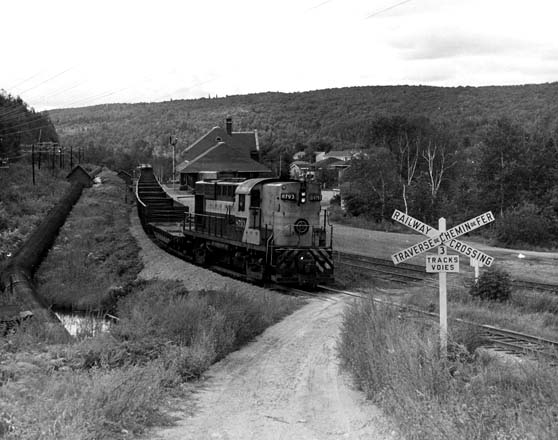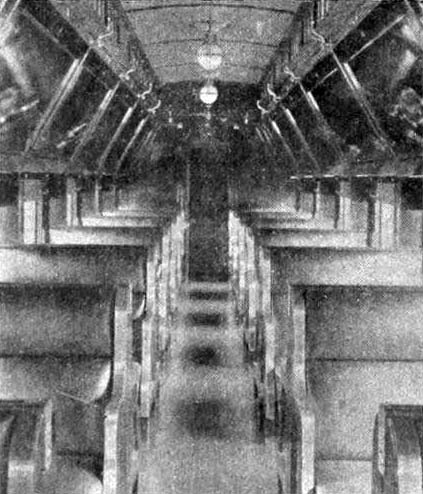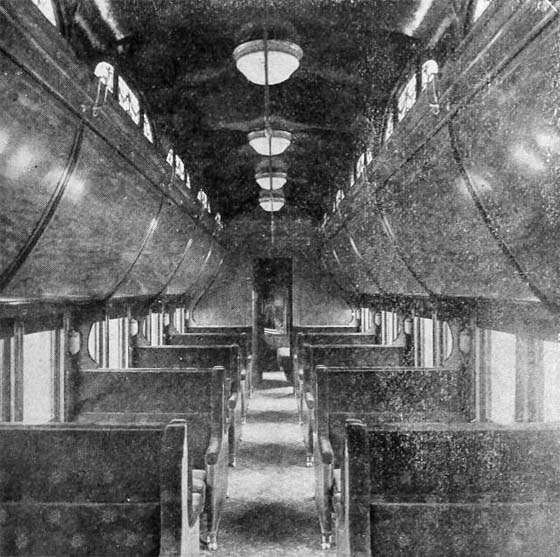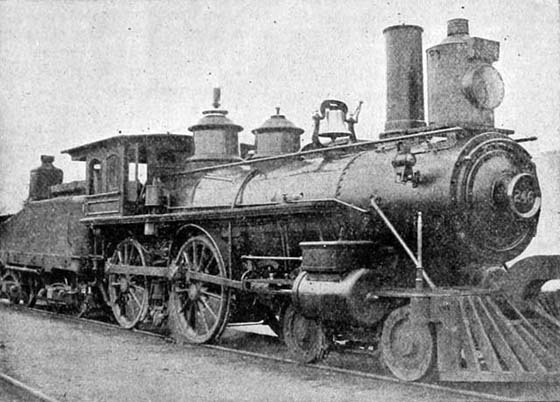 | Canadian Pacific Odds and Ends - Part 4 Articles |
Boats Ferry People from Bridge - Toronto Star and Bill Crago 1972. The "Last Call" page has appeared weekly on OKthePK's web site over the past couple of years. Each week a different article told the story about various railway items of interest. While some of the articles were saved they were no longer available online. Several of those about the Canadian Pacific Railway have been compiled here on this page. There is insufficient room to display more than a few articles per page. As a result, "Canadian Pacific Odds and Ends - Part 4", continues this month with more parts to follow as time progresses. Every month they will be archived to the CPR Set-off Siding web site for future online retrieval. Look under the articles section on the CPR Set-off Siding web site to find these archived pages. 8 May 1972  About 700 stranded on the west side of the rive spent the night on bunks at Canadian Forces Base Petawawa after the 260-foot bridge was closed to traffic and pedestrians Saturday midnight. They were ferried across the river yesterday by army assault boats and private craft. More than 4,000 soldiers and civilians who live in Petawawa village and Pembroke were in danger of being cut off from their jobs at the Atomic Energy of Canada Ltd. plant in Blind river or the armed forces base. But CP Rail set up a 6-mile shuttle service between Petawawa village and the military base. CP Rail has a trestle about a mile up-stream from the highway bridge. A seven-inch break in the bridge is endangering the water supply to Petawawa village's 6,000 residents. A water pipe runs along the bridge from the military base to the village and is reported leaking. Military engineers, who said they only had 200 feet of floating Bailey bridge available, said such a bridge wouldn't be feasible because the river was running too fast and high. The collapse, which caused schools in Petawawa to be closed because buses could not transport area children to the village, backed traffic up for six miles. One man complained he spent six hours sitting in his car before he was told of the collapse. Traffic between North Bay and Ottawa, 100 miles east of Petawawa, had to detour 100 miles through Algonquin Park. MP Len Hopkins (L-Renfrew) said last night he hopes to have the federal government declare the site of the bridge a disaster area. But Lt.-Col. J.R. Beveridge said the bridge's collapse was "an inconvenience but not an emergency". Anonymous Author. CPR and the Petawawa Bridge Petawawa Ontario - Late on a Friday night in the spring of 1972, a driver noticed a severe dip as he drove over the Petawawa River bridge on Highway 17 in Petawawa. Investigation revealed that the centre pier of the bridge had sunk about two feet. It was immediately closed. Remember this was several years before construction of the present Highway 17 Pembroke-Petawawa by-pass.
More serious were the following: One of the largest Canadian Forces bases was effectively isolated from the eastern part of the country. Many Forces personnel who lived in the PMQs (Permanent Married Quarters) or in private accommodation in Petawawa, Pembroke, and the surrounding area could not reach the base. The Trans Canada Highway was severed. Through traffic had to be detoured at Renfrew and North Bay by way of Huntsville and Algonquin Park. Employees of Ontario Hydro at Rolphton, AECL, and the National Forestry Station at Chalk River, and who lived in Pembroke or Petawawa could not get to work. In response, roads leading to a bridge located in the western extreme on the base training area were opened to the public. However, these were little more than bush trails and not capable of handling any significant traffic. It was about a 90 minute drive to get across the river! Through the considerable efforts of the local MP, the late Len Hopkins, by Monday three CP RDCs arrived in Petawawa. For the next couple of months they would shuttle between the Petawawa station and an open field near Camspur. This free service, I think ran 24 hours per day, but it might have been only about 20 hours, clearing as required at Petawawa for regular traffic.
Some others that worked elsewhere got a car to the far side, either by way of the military road or by way of North Bay. They left it parked in the field. A lot of car-pooling was done. Within a few days, the military had a pontoon bridge across the river near Petawawa Point, perhaps a half mile downstream from the doomed bridge. This was largely restricted to military traffic, but I recall my manager getting permission to cross provided he was at the location at a specified time. Plans were immediately started to put in place a pair of Bailey bridges immediately upstream. This work was largely done by military engineers. As I recall it took about six or eight weeks to complete. These bridges would remain in service until the new span was built, I think about two years later. This bridge remains in service today. I never took any photos of this operation. Taking a camera to work was not permitted, but why I did not get some photos on the weekend, I do not know. However, an AECL staff photographer did take a few photos one morning as we waited for the RDC shuttle at the Petawawa station. I was able later to get prints, scans of one of which is attached. Bill Crago.

 One feature of the Speno train at that time was a very robust public address system, so that Speno employees working around loud machinery could hear it. It was also like a party line phone system, except that the conversation was broadcast to the surrounding area via loudspeakers. And so, the Speno Work train talked out loud... usually in a New York City accent from whence most employees came. I think everyone on the CP crew has left the employ through retirement or resignation. Only one has since passed on. The crew were two engineers, two trainmen, conductor, cook, engineering technician, and often the roadmaster or his assistant. The train ground its way from Field to Kamloops over the period of about three weeks at three miles an hour. There was lots of "down time" as we cleared for other traffic, and at three miles an hour, you could walk faster than the train. You had to be careful of the grinders.
The conductor, another charming eccentric, was a scavenger and the caboose was loaded down with discarded items found along the tracks. He was also suing the entire world and carried a huge file of legal document with him at all times and would regale us with tales of courtroom dramas involving landlords, by-law officers and so forth.
Phil Mason. 
Our conductor on the train was named Clemens and Frank Smith was the brakeman. I didn't get the names of our engineer, fireman and flagman. All of those guys were extremely nice to us and let us have the run of the train. We rode many miles in the caboose cupola and we also got a cab ride. Here's the first photo taken at Kipawa Junction.
On the day earlier, Rahn and I rode the Mattawa train from Temiscaming to Kipawa Junction. The conductor on the Mattawa train was named Fields. Again, the crew let us ride in the caboose and we rode most of the way to Kipawa Junction in the cupola of conductor Fields' caboose. The caboose on the Mattawa train was a steel, center cupola caboose.
I get those two MLW's mixed up.
The way the crew explained it to us at the time, the Mattawa-Temiskaming train regularly exchanged some cars with the Temiscaming-Angliers train at Kipawa Junction (Gendreau). The conductor on the train in the photos was a Mr. Fields. The Temiscaming-Angliers crew called it "Fieldsie's Train". As mentioned before, Fieldsie's train had the steel CPR caboose with the center cupola.
My parents and aunt and uncle had rented a cabin on Lake Kipawa for the week and they picked us up at the dock after our ride. We coordinated all of this without cell phones! Can you believe it? One thing I forgot to mention previously was that the Mattawa-Temiscaming train (Fieldsie's train) ran on opposite days from the Temiscaming-Angliers train. The day that Rahn Stokes and I rode Fieldsie's train from Temiscaming to Kipawa Junction was likely on a Thursday. Our trip north to Angliers on the Temiscaming-Angliers train would then have been on a Friday and returning to Temiscaming on Saturday. How this assessment came up was the fact that the photo that Rahn forwarded to me of the Mattawa train in Temiscaming showed a different numbered RS-18 than in my photos of Fieldsie's train at Kipawa Junction (Gendreau). The answer then is that Rahn and I saw, and photographed that train, at Temiscaming after returning from Angliers on Saturday. The sequence of my photos on the 35mm negative strips shows that was what happened. Thus, I must have photographed Fieldsie's train twice.
It was many years ago and a lot of details have slipped from memory. Doug Leffler - Jackson, Michigan, USA.
 From June 17, 1904 to December 31, 1904 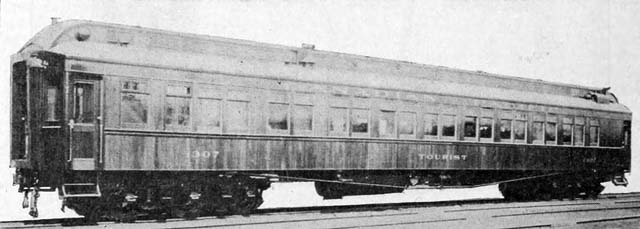 Exterior of new Canadian Pacific Tourist Car. The Canadian Pacific is building 27 tourist sleeping cars in its Montreal shops. Eight of these cars have already been finished and put into service between Boston, St. Paul, and Vancouver. A number of new features have been embodied in the design and the cars are as substantial and comfortable in every way as the standard sleeping cars, without of course, having such luxurious interior appointments.

The illustrations show one of a lot of thirty new sleeping cars being built for the Canadian Pacific by the Barney & Smith Car Company. These cars have a total length of 72 feet 8 inches over end sills, a total width of 9 feet 10 1/2 inches over side sills, with a height over all, from top of rail of 14 feet 5 9/16 inches. The entire design of framing as followed out is strictly in accordance with the standard as adopted by the Canadian Pacific, being wood throughout, with the exception of the end framing, which consists of six wrought iron end posts 3 feet by 5/8 inch, with ends turned at right angles and securely fastened to the end sills and end plates with 3 by 3 by 5/8 inch corner angles. The needle beams are rolled steel 5 inch by 8 inch buld tee irons, 20.2 pounds per foot. The outside sheathing is 13/16 inch mahogany. The inside finish is of the very best grade of Cuban mahogany throughout, with marquetry design of the Chipendale style, with the exception of the smoking room, which is of English oak with marquetry design. The ceiling is of 1/4 inch Agasote, canvas-faced, throughout the car, decorated in colors. The section seats and sofas in the main and state rooms are upholstered in green frieze plush, while the sofas and chairs in the ladies' toilet and gentlemen's smoking room are upholstered in Spanish leather. Particular attention has been paid to the lighting equipment of these cars, which is the Stone system, furnished by J. Stone & Company. It is their type, D.Z., 24 volt, axle light, with 24 cells of Stone batteries, arranged in parallel of 12 cells each. The upper berth lamps of these cars are of the latest design with automatic cut-out switches, which shut off the current as the bunk is closed up. The heating arrangement in these cars is the Gold duplex system of hot water circulation, with Frumweiler heater, controlled by the Canadian Pacific standard heat controller. The air brake arrangement as applied is the Westinghouse Air Brake Company's schedule L.N. 1612, with hand brake arrangement co-operating with same, and operating from both ends of the car. The trucks are of special design built-up steel 6 feet 10 1/4 inches wide with 11 feet 0 inch wheel base, of 80,000 pounds capacity, with 36 1/4 inch cast steel wheels equipped with Krupp steel tires, 5 inch by 9 inch journals, Simplex brake beams, American Brake Shoe & Foundry Company's cast steel back brake shoes, McCord journal boxes, and Susemihl side bearings. As a whole, these cars embody all of the latest designs and appliances known to the car-building art, being of most modern construction, presenting a beautiful appearance, and affording most comfortable conveniences to the traffic-riding public.

Editor: In the year 1889 the Canadian Pacific Railway Company put on a suburban train to run over a certain part of its line. Up to this time this work had been done altogether by a neighboring road, and when, for the convenience of passengers, the train in question was started, it was run exactly on the same time as the train on the other road, and it might be well to mention that these roads ran side by side for the whole distance, and the stations on each were directly opposite to each other. The train consisted of two 50,000 pound cars and a four-wheel coupled Manchester engine, with 16-inch cylinder and 62-inch wheels. The tank was sloped to the back, and a pilot put on the back of the tender as there was no means of turning engine at one end of the run. A few passengers patronized the new train, but when it was found that the little engine could not get there on time, and make all the stops, which were thirteen in a distance of 23 miles, they made very broad hints of going back to the other line. The engine on the other road was a remarkably good one, and was built for that particular service, with the water tank on the boiler, and it used to get out of the station with such surprising speed that the little Manchester could have a good view of the rear of that train when it did not get the smoke. This was too much for the feelings of not only the passengers, but engineer and conductor, and the former, in his eagerness to make better time, sometimes did not stop just at the station, even with the engine reversed, and the latter, with many apologies, would assist the passengers to alight at the road side. The brakes on the cars were in good order and fully equal in power to ninety percent of weight of car, the tender brake was equally good, but the driver brake was of the pull-up type, with the usual gland leakage. To keep the piston packing tight, the engineer was accustomed, when oiling, to carry an oil can in one hand and a water can in the other. This brake was made to do good work by turning the cylinders upside down, changing the pistons on the rods, putting on a long cross head, and making it push up instead of down and use no gland. Bright sheet tin was placed between the cylinder and the firebox, and the leather packing was put in quite dry. The bright tin acted as a non-conductor, and kept the cylinder much cooler. After this was done, the time made was so much improved that the value of a brake for making time began to dawn upon the writer of this article, who at the time, had charge of the mechanical department at that point. There were two pair of wheels yet in the train without a brake, the engine truck, with a weight of 25,000 pounds, the energy of which pulled the train by the station, and made it necessary to shut off sooner. Why not put a brake on the engine truck? The reasons against it were, that no such brake had yet been used, and the engine truck was supposed to be free to curve. The reasons for it were time and safety, and that this engine had a brake on the leading truck when running tender first, which furthermore hung to the tender frame, while the engine-truck brake could be made to hang to the truck itself. An 8-inch cylinder, a 10 x 24 inch reservoir, and a triple valve, were soon on hand. Slab-iron brake beams, with wrought-iron brake heads, were quickly made and placed inside of the wheels, over pedestal braces, so that no safety hangers were needed, and a braking power of ninety percent was employed. The result was that the little engine brought its train in sharp on time, to the satisfaction of everybody. The accompanying photograph is of the engine with the first engine-truck brake. C.R. Ord - A.B. Insp., C.P.R. Montreal, Canada. |
